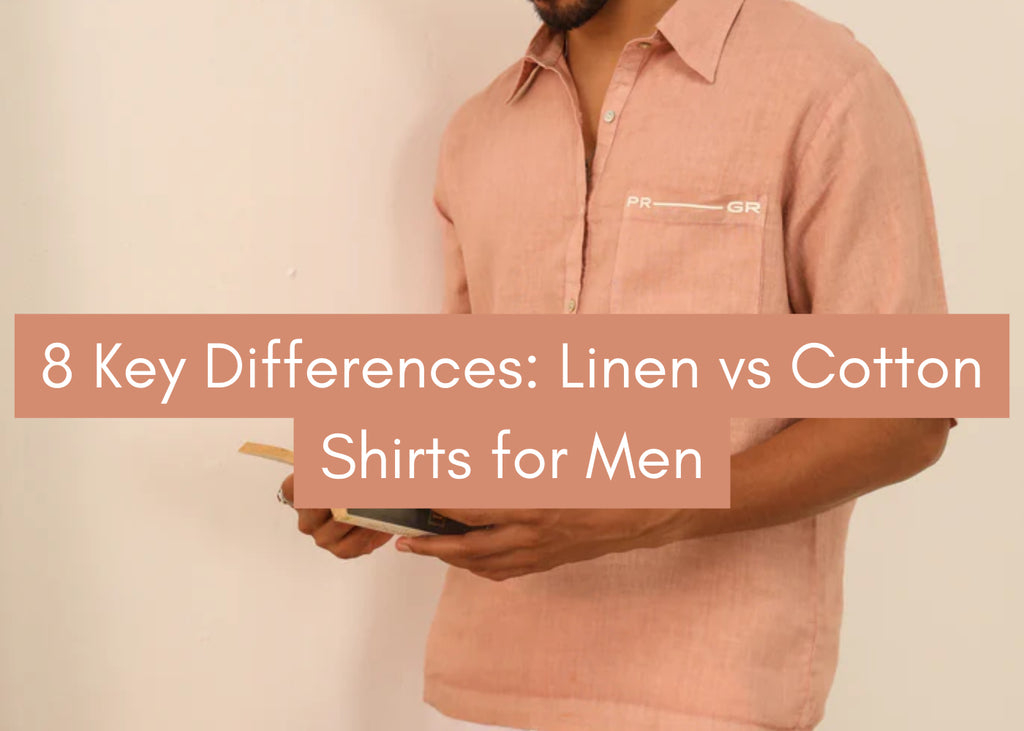8 Key Differences: Linen vs Cotton Shirts for Men
Posted by Primal Gray

Choosing the right shirt fabric can make or break your comfort, especially during sweltering summer months. The eternal debate between linen vs cotton shirt options has left many men scratching their heads at their wardrobes. With rising temperatures and increasing awareness about sustainable fashion, understanding the difference between linen and cotton has become more crucial than ever.
Understanding The Fabric Fundamentals of Linen vs Cotton
Linen and cotton are both natural plant-based fabrics, but they differ significantly in their fibers, texture, and properties. Linen, derived from the flax plant, is known for its exceptional strength, superior breathability, and characteristic tendency to wrinkle easily. Cotton, harvested from the cotton plant, offers unmatched softness, incredible versatility, and maintains a smoother appearance with less wrinkling.
Think of it this way: if cotton is like a gentle, reliable friend who's always there for you, linen is that adventurous companion who gets better with every shared experience. For instance, a cotton shirt feels immediately comfortable right out of the package, while a linen shirt reveals its true character after several washes, becoming softer and more luxurious over time.
8 Key Differences in Linen vs Cotton Shirts for Men
1. Fiber Source and Construction
The fundamental difference between linen and cotton lies in their origins. Linen shirt men's collections feature fabric made from flax plant fibers, which are notably longer and stronger than their cotton counterparts. These flax fibers can be up to 30% more enduring than cotton fibers, making linen inherently more robust.
Cotton shirt men's options, conversely, utilize fibers that surround cotton plant seeds. These shorter, softer fibers create a completely different wearing experience. The fiber length directly impacts everything from durability to texture, explaining why linen feels more structured while cotton feels more pliable.
2. Texture and Initial Feel
When you first touch a linen shirt, you'll notice its crisp, slightly rough texture that might surprise those accustomed to softer fabrics. This initial coarseness isn't a flaw, it's a feature that transforms beautifully over time. Each wash makes linen softer and more comfortable, eventually achieving a luxurious feel that cotton struggles to match.
Cotton shirts offer immediate gratification with their smooth, soft texture right from the start. However, this initial softness tends to fade with repeated washing and wear, while linen's comfort actually improves with age.
3. Breathability and Temperature Regulation
Here's where linen truly shines as the best summer shirt fabric. Linen's loose weave structure allows exceptional airflow, making it incredibly breathable. The fabric's ability to wick moisture away from your body ensures a constantly cooling effect, keeping you dry and comfortable even in humid conditions.
Cotton shirts are also breathable, but they tend to absorb and retain moisture rather than wicking it away. This means cotton can feel heavier and warmer during hot, sweaty conditions, though it remains comfortable for everyday wear.
4. Durability and Longevity
Linen vs cotton durability reveals a clear winner. Linen is one of the strongest natural fibers available, with tensile strength significantly higher than cotton. This exceptional durability means linen shirts can withstand frequent wear and washing while actually improving in comfort and appearance over time.
Cotton shirts, while durable in their own right, are generally less long-lasting than linen. They tend to wear out more quickly with repeated washing and may lose their strength over time, especially in high-friction areas.
5. Wrinkle Resistance and Appearance
The difference between linen and cotton becomes most apparent when discussing wrinkles. Linen's stiffer fibers make it prone to wrinkling, which can be viewed as either a charming, lived-in aesthetic or a maintenance challenge, depending on your perspective. Many fashion enthusiasts embrace linen's natural wrinkled look as part of its effortless sophistication.
Cotton shirts are significantly less prone to wrinkling, maintaining a smoother appearance throughout the day. This makes cotton more suitable for formal settings where a crisp appearance is essential.
6. Comfort and Skin-Friendliness
Linen shirt benefits extend beyond temperature regulation to actual health advantages. Linen is naturally hypoallergenic and possesses antibacterial properties that cotton lacks. It's particularly beneficial for sensitive skin, helping to prevent irritation and reduce skin conditions like rashes and eczema.
Cotton is generally comfortable and suitable for most skin types, though it doesn't offer the same hypoallergenic and antibacterial benefits as linen. However, cotton's immediate softness makes it more appealing to those who prioritize instant comfort.
7. Environmental Impact and Sustainability
The sustainability comparison reveals linen as the clear environmental champion. A linen shirt requires only about 6.4 liters of water to produce, compared to cotton's staggering 2,700 liters. Flax plants used for linen production require fewer pesticides and can grow in poorer soil conditions, making them more environmentally friendly.
While organic cotton options exist, conventional cotton production typically demands more water and chemical inputs than linen production. This makes linen the more sustainable choice for environmentally conscious consumers.
8. Care Requirements and Maintenance
Cotton shirt benefits include easier care and maintenance. Cotton can typically be machine washed in hot water, tumble dried, and requires minimal special attention. It's more forgiving of aggressive washing techniques and maintains its appearance with standard care routines.
Linen requires more thoughtful care, though it's not as high-maintenance as many believe. Cold water washing, gentle detergents, and air drying help preserve linen's quality and extend its lifespan. The silica present in flax fibers actually helps protect linen against rotting and dirt, making it naturally resistant to deterioration.
Product Spotlight on Premium Options for Every Preference
For those seeking the perfect linen experience, consider the Kimono Polo Shirt crafted from GOTS-certified organic linen. This oversized design features wide, flowing sleeves and a relaxed collar, perfect for laid-back summer gatherings. The moisture-absorbing, thermoregulating properties make it ideal for warm weather comfort.
The Oversize Panel Shirt offers a more structured approach to linen wear, featuring dropped shoulders and exaggerated long sleeves with distinctive contrast stitching. For those preferring cotton's versatility, the Patch Work Shirt showcases organic cotton's comfort with asymmetrical detailing and curved edges.
How Primal Gray Brings you the Best Summer Fabrics
Primal Gray understands the complexity of choosing between linen and cotton, which is why they offer premium options in both fabrics. Their GOTS-certified organic materials ensure you're getting the highest quality whether you choose the breathable luxury of linen or the versatile comfort of cotton. Each piece is crafted with impeccable attention to detail, helping you make the right choice for your lifestyle and preferences.
Ready to experience the difference? Explore Primal Gray's collection and discover your perfect shirt fabric today.
Key Takeaways
- Linen excels in hot weather with superior breathability and moisture-wicking properties, making it the best summer shirt fabric for humid climates.
- Cotton offers immediate comfort with its soft texture and easier care requirements, ideal for everyday wear and formal occasions.
- Linen provides better durability and actually improves with age, while cotton offers more wrinkle resistance and consistent appearance.
- Environmental impact favors linen significantly, requiring 99% less water than cotton production and fewer chemical inputs.
- Skin sensitivity benefits from linen's hypoallergenic and antibacterial properties, though cotton remains suitable for most skin types.
- Investment value differs substantially, linen costs more initially but lasts longer, while cotton provides affordable immediate satisfaction.
Frequently Asked Questions
1. What is the difference between linen and cotton shirts?
The primary differences lie in their source materials, texture, and performance characteristics. Linen comes from flax plants and features longer, stronger fibers that create a crisp, textured feel and exceptional breathability. Cotton derives from cotton plant fibers, offering immediate softness and smoother texture. Linen excels in hot weather due to superior moisture-wicking properties, while cotton provides more versatility across different occasions and easier maintenance requirements.
2. Which is better for summer: linen or cotton?
Linen is generally superior for summer wear due to its exceptional breathability and moisture-wicking capabilities. The loose weave structure allows maximum airflow, while its ability to absorb up to 20% of its weight in moisture keeps you dry and comfortable. Linen's thermoregulating properties provide a constant cooling effect, making it ideal for hot, humid conditions. Cotton, while breathable, tends to retain moisture and can feel heavier in extreme heat, though it remains comfortable for moderate summer temperatures.
3. Are linen shirts more expensive?
Yes, linen shirts typically cost more than cotton shirts due to several factors. The flax cultivation and processing require more labor-intensive methods, and the limited availability of quality flax contributes to higher raw material costs. Additionally, linen's superior durability and luxury positioning justify premium pricing. However, linen's exceptional longevity means better cost-per-wear value over time, as these shirts can last decades with proper care, while cotton shirts may need replacement more frequently.
4. How do you care for linen vs cotton shirts?
Cotton shirts are generally easier to care for, accepting machine washing in warm water and tumble drying with minimal special requirements. Linen requires more thoughtful care but isn't overly complicated. Use cold water, gentle detergents, and air drying for best results. Linen benefits from steaming rather than ironing to remove wrinkles, and its natural silica content actually helps resist dirt and deterioration. Both fabrics should be stored in breathable containers and kept away from direct sunlight when not in use.
5. What are the pros and cons of each fabric?
Linen pros include superior breathability, exceptional durability, hypoallergenic properties, environmental sustainability, and improving comfort over time. Cons include higher initial cost, tendency to wrinkle, and more careful washing requirements. Cotton pros feature immediate softness, wrinkle resistance, easier care, lower cost, and versatility across occasions. Cotton cons include less durability, reduced breathability in hot weather, higher environmental impact, and tendency to lose softness over time with repeated washing.
6. Do linen shirts shrink more than cotton shirts?
Both linen and cotton can shrink, but cotton generally has higher shrinkage potential, especially when exposed to hot water and high heat drying. Linen, when properly pre-treated and cared for with cold water washing and air drying, experiences minimal shrinkage. The key difference lies in care requirements – cotton's tolerance for hot water washing can lead to unexpected shrinkage, while linen's preference for gentle care naturally prevents most shrinkage issues. Quality pre-shrunk versions of both fabrics minimize this concern significantly.












